The journey to the Retired Racehorse Project Thoroughbred Makeover continues — now slated for 2021. Read on for our sixth update from Marion Edel.
My last blog post was in early July, right before the Retired Racehorse Project’s announcement that they were canceling this years Thoroughbred Makeover due to COVID-19. 2020 competitors will have the option to compete at a Mega Makeover in 2021, with divisions for both the 2020 and 2021 horses. I was thrilled with the RRP’s decision, as I starting to get a little antsy about traveling and competing in an international competition during a pandemic. More time will also be hugely beneficial for my 17.1+ hand, potentially still growing, 6-year-old partner.
Now more than ever, I’m thankful to have another year of preparation. Horse ownership gives the highest of highs along with the lowest of lows. Those peaks and valleys are par for the course with these large but surprisingly fragile animals. I promised myself that when I started blogging for Jumper Nation, I was going to be completely transparent with my journey with Grey – good, bad, or ugly. Well, here’s the reality: Our very positive and relatively easy restarting journey took a turn a few weeks ago. There is light at the end of the tunnel, but we’ve had a tough time recently.
I’ll start from the beginning. My mom had minor eye surgery in mid-August, and her recovery dictated that she couldn’t be around dust or dander for 10 days to two weeks. We decided that the easiest solution was for me to come up to North Carolina, work remotely, help with her surgery recovery, and cover the barn shifts. Since I was going to be away from home for at least 10 days, and conveniently now have a truck and trailer (Julie’s first big road trip!), I decided to bring Grey with me.
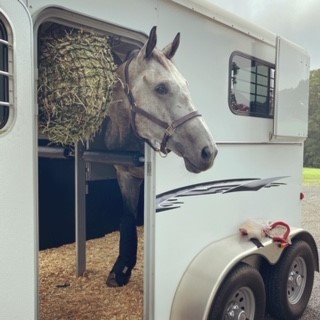 Grey was a super star for the 3 hour trip from Greenville, SC to Winston-Salem, NC. He self-loaded onto the trailer and was relaxed when I checked on him halfway through the trip. He unloaded well at my parent’s farm, checked out his surroundings with interest and promptly settled right in. The first time I turned him out, he just walked away from the gate like he had lived there his whole life. No running, no screaming for his buddies, just a proud mom moment for me. Here he is left, checking out his new temporary digs in North Carolina.
Grey was a super star for the 3 hour trip from Greenville, SC to Winston-Salem, NC. He self-loaded onto the trailer and was relaxed when I checked on him halfway through the trip. He unloaded well at my parent’s farm, checked out his surroundings with interest and promptly settled right in. The first time I turned him out, he just walked away from the gate like he had lived there his whole life. No running, no screaming for his buddies, just a proud mom moment for me. Here he is left, checking out his new temporary digs in North Carolina.
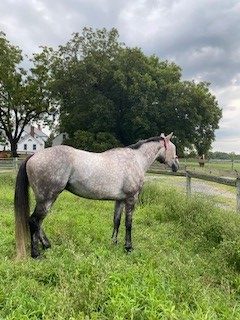 The first week at my parents’ farm passed in a blur of working remotely, driving my mom to Duke and helping with her aftercare and feeding and turning out the 17 horses on the property. I got up around 6:00am every day to ride before I started working at 8:00am. Other than the actual day of my mom’s surgery, I rode every day that week. Grey was just as quiet under saddle at my parents’ farm as he was at home in Greenville. Right, here he is hanging out in his field at their farm. We rode in their covered arena but would also spend a lot of time hacking around the farm. There are no shared fence lines at my parent’s farm. Every field is separated by a lane that goes around the whole pasture, perfect for hacking outside the ring.
The first week at my parents’ farm passed in a blur of working remotely, driving my mom to Duke and helping with her aftercare and feeding and turning out the 17 horses on the property. I got up around 6:00am every day to ride before I started working at 8:00am. Other than the actual day of my mom’s surgery, I rode every day that week. Grey was just as quiet under saddle at my parents’ farm as he was at home in Greenville. Right, here he is hanging out in his field at their farm. We rode in their covered arena but would also spend a lot of time hacking around the farm. There are no shared fence lines at my parent’s farm. Every field is separated by a lane that goes around the whole pasture, perfect for hacking outside the ring.
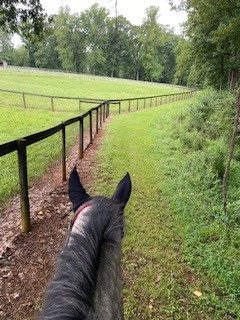
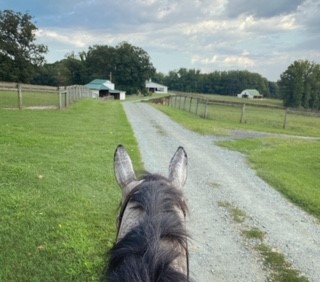
Exploring on the farm. Photos by Marion Edel.
Starting the second week, things began to change day by day. When I rode Grey, he was spookier going by the other horses and a little more reactive in the ring and hacking out. By the middle of that second week, I had a completely different horse than the one I’ve come to know over the last nine months. Grey has been the definition of a “steady eddy” since I met him in November 2019 – He rarely spooks and never gets tense or tight. As I rode him down the arena that Thursday, he spooked almost the whole way, and when I asked him to trot for the first time in the arena, he exploded. I tried to work through it for a few minutes, but I wasn’t getting anywhere. Grey felt was so tight in his body that I could feel his heart beating frantically under my leg.
I like to think I’m a brave rider, but I also know when a situation isn’t worth my safety. Once I got Grey to stop spinning, crow hopping and spooking, I jumped off and grabbed a lunge line. My first thought was that maybe he was just having an “off day” and needed to blow off some energy on the lunge. As soon as I asked him to trot off on the lunge line, Grey bolted and while I held onto him, I couldn’t get him to stop for a while. Grey was totally checked out, zooming around on the lunge line, farting and then bolting again every time he heard his own fart. In other circumstances, it might have been funny.
Once I finally reeled him back in and got him to walk, I figured the safer option would be to take him to the round pen. The round pen was specifically designed for starting young horses, so the walls are solid wood until about the horse’s head level, then wall is slatted. It’s very difficult for a horse to hurt themselves in that round pen and it was the safest option for Grey.
I could hardly watch Grey as he tore around on the lunge line. The name of the game was survival – Don’t get hurt, don’t let the horse get hurt, don’t let him get free, slow him down and get him stopped. Once Grey was free in the round pen, I could actually WATCH him as he continued to spook and bolt. What I saw wasn’t normal for Grey. He was falling out behind, cross cantering or cantering with both hind legs together. Every time he tried to fix himself and canter correctly, his hind legs would fall out of rhythm again. After a few more minutes of zooming around, I think he wore himself out and finally stopped.
Once I got Grey back to the barn, hosed him off and turned him out, I sat down in the barn aisle and cried. It was heartbreaking to see my horse in that kind of state and not know how to help him. I knew that something had to be wrong with Grey for him to act so out of character, but I had no idea what it could be.
 The next morning, Grey wasn’t quite as explosive, but he still wasn’t himself and he wasn’t entirely sound. I texted my vet and we scheduled an appointment for Monday, three days away. I trailered back to South Carolina over the weekend and while Grey was spooky, he settled back in relatively well. The best part about being home was walking out the back door and seeing him.
The next morning, Grey wasn’t quite as explosive, but he still wasn’t himself and he wasn’t entirely sound. I texted my vet and we scheduled an appointment for Monday, three days away. I trailered back to South Carolina over the weekend and while Grey was spooky, he settled back in relatively well. The best part about being home was walking out the back door and seeing him.
When my vet came out on Monday, we started with general palpations and a lameness exam. He was so sore my vet could barely palpate him over his back and hindquarter. He quickly turned into an oversized snapping turtle, and it was obvious that he was in a lot of pain. When we did the lameness exam, Grey was off on the left hind, but also showed the occasional lameness up front. We decided to make an appointment to scope for ulcers the following week and got to work doing chiro and acupuncture. While doing acupuncture, my vet decided to treat the EPM points.
Grey always enjoys his chiropractic and acupuncture treatments, but if he’s really in pain somewhere, he can get a little squirrely. That was the case with the EPM points. Once they were treated, Grey had the biggest tension release I’ve seen in a horse, responding with multiple yawns and full body shakes. The vet palpated him again, and amazingly, 70% of the body soreness we saw when she first checked him was gone.
The acupuncture treatment of the EPM points, coupled with his odd behavior and shifting lameness, prompted the decision to test for EPM – Equine Protazoal Myeoloencephalitis. I also asked to test for Lyme, which is rare in our area, but I wanted to test just in case. The gold standard of testing for EPM is a spinal tap, which is the only way to detect an active infection. I opted for the less invasive route – a blood test.
The following week, we scoped for ulcers and found Grade 1 – enough to treat, but not enough to explain Grey’s behavior. The Lyme test came back negative, but the EPM results from UC Davis showed significantly elevated antibody levels, leading us to believe that Grey has an active EPM infection. As I mentioned, the only definitive way to diagnose an active infection is with a spinal tap, but with the antibody levels as high as they were, we decided to go ahead and treat for EPM with Protazil, an FDA approved prescription, Vitamin E to support healthy nerve function, and an immune system supplement.
I’ve done a lot of research on EPM since the first vet appointment, and I swear EPM is something straight out of a science fiction novel. I knew what it was and knew horses that had it, but I had never seen it present with the symptoms Grey has. All the EPM horses I was aware of were very neurological. They couldn’t tell where their feet were, and they struggled to keep their balance and even stand. Grey just had severe body soreness, a slight, shifting lameness between front and hind legs and a significant personality change. EPM never occurred to me as a potential cause of his symptoms until my vet suggested we look into it.
EPM is described as the “master of disguise,” since it can present with the same symptoms as so many other conditions. There’s no way to tell where a horse was exposed or how long ago that was. I will never know why Grey started showing symptoms when he did, and he could have been exposed months ago, or even years ago. Even though he settled in easily and seemed comfortable, I wonder if traveling and living at another farm was stressful enough to cause a flare up.
If you’re not familiar with EPM here is the Spark Notes version:
- EPM is caused by a protozoal parasite from the opossum
- It is not spread horse to horse
- An infected opossum will poop around a food or water source, and the horse is exposed by coming into contact with the contaminated grass, food or water
- It is thought that up to 50% of horses may have been exposed to EPM, but clinical disease only presents in approximately 1% of exposed horses
- Once ingested, if the horse’s immune system fails to eradicate the parasite, it crosses the blood/brain barrier into the brain and spinal cord, and starts attacking the nervous system
- Some horses can harbor the organisms for months or even years, before developing symptoms
- Symptoms can appear suddenly or gradually and can include: incoordination/clumsiness, abnormal gait or lameness, seizures, collapse, paralysis of the muscles of the eyes, face or mouth, spookiness/reactivity, muscle atrophy, lack of topline, body soreness, clumsiness, heat intolerance, etc.
It’s gut wrenching to see how the disease is affecting my horse, and I keep reminding myself that his case is MILD compared to most. I’m thankful that Grey isn’t more neurological, but it’s still hard for me to watch the radical changes in his behavior. Everyone who is handling him right now is extra cautious, since Grey’s spookiness has increased in the last couple of weeks. Grey was always safe and kind enough to be led into the barn by the Pony Club kids, and I hope he will get back to that, but he may not. Just this morning when I was bringing him in from the field, he spooked, bolted and got away from me. Thankfully, we were still in the pasture with the gate closed, but it was good reminder that he’s not himself. When I went to catch him again, his heart was racing, his whole body was tense, the whites of his eyes were showing and he seemed truly terrified.
I miss riding my horse, but at this point, I just want him to be comfortable and happy again. I hate that his nervous system is so fried that his flight instinct is in overdrive. I’m sad that his muscles are so sore that I have to be careful how I groom him. I hate that when I watch him move freely out in the field, he’s not entirely sound.
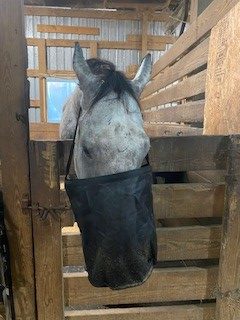 All Grey’s new supplements have arrived, and by the time this blog is published, he will have started on Protazil. My vet is confident that he will make a full recover, and I’m trying to stay optimistic and positive. One of the fascinating things about EPM is that most of Grey’s ongoing “issues” could fall into the symptom category. I’m confident that the shifting lameness, body soreness and increased spooking and reactivity are all EPM symptoms, but there’s a chance that additional symptoms could be his under-developed topline, lack of hind end muscle, excessive sweating, twitching upper lip and dragging his hind left toe. It will be interesting to see what improves and what doesn’t. Meanwhile, there’s no chance of Grey dropping any medication or supplements with this feedbag.
All Grey’s new supplements have arrived, and by the time this blog is published, he will have started on Protazil. My vet is confident that he will make a full recover, and I’m trying to stay optimistic and positive. One of the fascinating things about EPM is that most of Grey’s ongoing “issues” could fall into the symptom category. I’m confident that the shifting lameness, body soreness and increased spooking and reactivity are all EPM symptoms, but there’s a chance that additional symptoms could be his under-developed topline, lack of hind end muscle, excessive sweating, twitching upper lip and dragging his hind left toe. It will be interesting to see what improves and what doesn’t. Meanwhile, there’s no chance of Grey dropping any medication or supplements with this feedbag.
I hope that my next blog update will be a happy one, where I can tell everyone he’s made a full recovery and is back to himself, but only time will tell. In the meantime, I hope that Grey’s story will be beneficial to someone else whose horse may be exhibiting odd symptoms or a radical change in temperament.
About Marion
Marion Edel is an adult amateur who lives in Greenville, SC with her husband, Chris. They share their home with a Rhodesian Ridgeback and two cats. Marion grew up on a Hanoverian breeding farm and has been riding her entire life, focusing mostly on hunters and jumpers. Marion recently purchased her first OTTB and is a first time trainer for the 2020 Thoroughbred Makeover.
